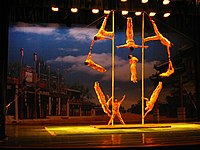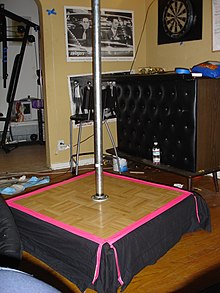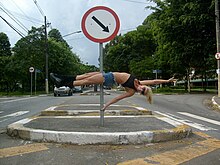Pole dance: Difference between revisions
| Line 14: | Line 14: | ||
It is probable pole dancing started in America in the 1920s depression, with dancers in traveling shows using a tent pole as a prop.{{Citation needed|date=August 2010}} The relationship to [[Chinese pole]]s is unclear, Chinese troupes performed in [[Ringling Bros. and Barnum & Bailey Circus|Barnum and Bailey's Circus]] from 1914 but they did not perform on poles.<ref>{{cite web|author=[ Displaying Abstract ] |url=http://query.nytimes.com/gst/abstract.html?res=9F02E3DE163BE633A25754C0A9629C946796D6CF |title=Barnum Bailey Circus opens in Madison Square Garden 1914 |publisher=New York Times |date=2010-09-05 |accessdate=2010-09-27}}</ref> |
It is probable pole dancing started in America in the 1920s depression, with dancers in traveling shows using a tent pole as a prop.{{Citation needed|date=August 2010}} The relationship to [[Chinese pole]]s is unclear, Chinese troupes performed in [[Ringling Bros. and Barnum & Bailey Circus|Barnum and Bailey's Circus]] from 1914 but they did not perform on poles.<ref>{{cite web|author=[ Displaying Abstract ] |url=http://query.nytimes.com/gst/abstract.html?res=9F02E3DE163BE633A25754C0A9629C946796D6CF |title=Barnum Bailey Circus opens in Madison Square Garden 1914 |publisher=New York Times |date=2010-09-05 |accessdate=2010-09-27}}</ref> |
||
Pole dancing gradually began evolving from tents to bars as burlesque became more acceptable in the 1950s.{{Citation needed|date=August |
Pole dancing gradually began evolving from tents to bars as burlesque became more acceptable in the 1950s.{{Citation needed|date=August 2010}} |
||
==The pole== |
==The pole== |
||
Revision as of 21:54, 26 February 2011


Pole dancing is a form of performing art, a combination of dancing and gymnastics. It involves dancing sensually with a vertical pole and is often used in strip clubs and gentlemen's clubs. A similar pole (Chinese poles) is used in cabaret/circus and stage performance in a non-erotic environment, in which context the style and moves are very different.
Advanced pole dancing requires significant strength, flexibility and endurance. In a strip club setting, pole dancing is often performed less gymnastically and combined with striptease, Go-Go, and/or lap dancing between performers. The dancer(s) may simply hold the pole, or use it to perform more athletic moves such as climbs, spins, and body inversions. Upper body and core strength are important to proficiency, which takes time to develop.[1]
Pole dancing is now regarded as a recognized form of exercise[2] and can be used as both an aerobic and anaerobic workout.[3] Recognized schools and qualifications are being developed as pole dancing increases in popularity, with the overall sex appeal toned down.[4]
History



It is probable pole dancing started in America in the 1920s depression, with dancers in traveling shows using a tent pole as a prop.[citation needed] The relationship to Chinese poles is unclear, Chinese troupes performed in Barnum and Bailey's Circus from 1914 but they did not perform on poles.[5]
Pole dancing gradually began evolving from tents to bars as burlesque became more acceptable in the 1950s.[citation needed]
The pole
Standard pole
The standard dance pole typically consists of a hollow steel or brass pole with circular cross section, running from floor to ceiling. Affixing at the ceiling gives more stability, but is not always realized, especially at night clubs with higher ceilings or at transportable devices. In the United States, the diameter is usually around 5 cm (2 inches), allowing it to be gripped comfortably with one hand. In Asia, the diameter is usually slightly smaller at 4.5 cm or less.
Another common pole is the spinning pole; as its name suggests, it is similar to a standard dance pole but spins using ball bearings. The purpose of this pole is to create better momentum and higher rates of speed, in order to have a greater dramatic effect.
Home versions are available which may be used for practice or aerobic exercise. Materials of which poles are made include polished stainless steel, chromed steel, brass, powder coating, and Titanium coating. Poles can also be made of acrylic glass which allows use of "glow poles" with LED lighting effects. Each material surface has different gripping properties. Polished steel is one of the slickest materials, which provides for a faster, more fluid dance; brass poles provide more friction, allowing for an easier hold with hands or thighs and creating a slow, sensual dance style.
Poles can be held in place by using threading to brace them against a ceiling joist. There are also poles that do not require construction and can be set up using tension. Stationary, rotating, and switchable versions are available.
Show pole
There are now poles available for use in clubs that provide visual effects. These poles are made with clear plastics and contain water, glitter, and special reflective materials which stand out when used in conjunction with strobe lighting, as well as lighting hidden in their base joists. However, these poles are not favorable to a dancer wanting to achieve better pole tricks, as they bend slightly and have a tendency to create a friction burn when slid down with any sort of speed.
Pole dance as exercise

Pole dancing has gained popularity as a form of exercise, with increased awareness of the benefits to general strength and fitness.[6] This form of exercise increases core and general body strength by using the body itself as resistance, while toning the body as a whole. It is also generally reported by pole dancing schools to be empowering for women and to build confidence. [7]
Pole dancing as an exercise is very similar to Mallakhamb, an Indian men's sport with no erotic component, but there is no evidence of a link.
A growing number of men are incorporating pole dancing into their fitness programmes.[8][9] In Australia, the UK and the US, dance studios are beginning to offer classes just for men. And in China, 2007's National Pole Dancing competition was won by a man. Dance instructor Zhang Peng, 23, beat a host of women dancers to the top prize.[10]
Pole dance competitions
Although the most common pole dance competitions are still amateur nights at strip clubs, there is a growing community who are trying to get pole dancing taken seriously as a sport and art form. There are local pageants held in venues such as Australia, France, Canada, Japan, the Netherlands and the UK. More recently, amateur pole dance competitions have been held. These are strictly non-nude and non-stripping, and focus on pole dance as an athletic and artistic form of dance and exercise. The first "Miss Pole Dance World" competition [1] was held in november 2005, and Reiko [2] Suemune from Japan won the championship.
Pole dance competitions have attempted to shy away from amateur nights at strip clubs. These events are strictly non-nude and non-stripping with the focus placed on the athleticism and artistry of the performer rather than on pure sex appeal.
A group of advocates are even pushing for pole dancing to be represented as a test event in the 2012 London Olympics.[11][12] But because this is a relatively new trend, scoring for competitions is not standardised, while names of the techniques vary among different clubs in different regions.[13]
In Australia, "Miss Pole Dance Australia" was started in 2005. Felix Cane took home the first prize in the latest 2010 (named miss pole dance 2011- for the coming year) competition, .[14] The first US Pole Dance Federation (USPDF) Championship was held on March 19, 2009, first place was taken by Jenyne Butterfly.[15] The 2010 winner of "Miss Pole Dance Canada" was Crystal Lai, who went on to win the People's Choice Award at the worlds. [16]Miss Pole Dance World 2009, which was held in Jamaica and opened to all nationalities, was won by Australian Felix Cane.[17] Miss Pole Dance World 2010 which took place in Switzerland and was opened to all nationalities, was again won by Australian Felix Cane.[18]
Pole dance in the media
Like other trends, pole dancing has its share of celebrity following. Actress Sheila Kelley was so taken with the sport, which she learned while preparing for her role in Dancing at the Blue Iguana, that she launched her own pole-based exercise programme.[19]
Rima Fakih's victory at Miss USA 2010, including the fact that she had won a pole-dancing competition three years earlier, attracted media attention. [20]
See also
References
- ^ Pole Dancing is empowering Performance Art, http://www.wbur.org/2010/04/02/pole-dance
- ^ Pole dancing: It's not just for strippers anymore, http://abcnews.go.com/Travel/pole-dancing-strippers-anymore/story?id=10168196
- ^ Pole dancing for exercise, http://www.kpsplocal2.com/Content/Special-Feature/story/Pole-Dancing-for-Exercise/iao4iYWMV0qNfw1OP6b3Sw.cspx
- ^ Cambridge University society offers pole dancing tuition, http://www.google.com/hostednews/afp/article/ALeqM5jNVin7NeCHRArbeJRkTPdttX8QzQ
- ^ [ Displaying Abstract ] (2010-09-05). "Barnum Bailey Circus opens in Madison Square Garden 1914". New York Times. Retrieved 2010-09-27.
- ^ Stripping Off The Weight, CBS News website, retrieved on 8/20/2007.
- ^ http://www.news.com.au/breaking-news/cambridge-university-society-offers-pole-dancing-tuition/story-e6frfku0-1225853143529
- ^ Wong, Amanda (2010-01-27). "Pole dancing for men?". Straitstimes.com. Retrieved 2010-09-27.
- ^ Men's pole dancing better than just hanging around, http://sydney-central.whereilive.com.au/news/story/mens-pole-dancing-better-than-just-hanging-around/
- ^ "Watch out, men on poles". Asiaone.com. Retrieved 2010-09-27.
- ^ Pole dancing could be recognized as a sport and headed to the Olympics ,http://www.nydailynews.com/lifestyle/2010/02/23/2010-02-23_pole_dancing_could_be_recognized_as_a_sport_and_headed_to_the_olympics_.html
- ^ Recognize Pole Dancing as New Olympic Sport, http://www.bhsjacket.com/node/420
- ^ Get ready sports fans, pole dancers eye Olympics, http://sports.yahoo.com/olympics/news?slug=ap-goldenpoles
- ^ "Miss Pole Dance Australia". Miss Pole Dance Australia. Retrieved 2010-09-27.
- ^ http://www.youtube.com/v/8_NJiwIVu6k?fs=1&hl=en_US
- ^ "Miss Pole Dance Canada".
- ^ "World Pole Dance Championships Jamaica 2009 - World Pole Sport Fitness". Worldpoledance.com. 2009-04-25. Retrieved 2010-09-27.
- ^ "World Pole Fitness Championships 2010 - World Pole Sport Fitness". Worldpoledance.com. Retrieved 2010-09-27.
- ^ Pole-dancing: Do you have what it takes?, http://www.ellecanada.com/living/health/pole-dancing-do-you-have-what-it-takes/a/24943
- ^ "Miss USA 2010 Winner a Pole Dancer - Rachel Uchitel Poses for Playboy". National Ledger. May 17, 2010. Retrieved May 19, 2010.
External links
- Miss Pole Dance Australia: Finals! - slideshow by Life magazine
